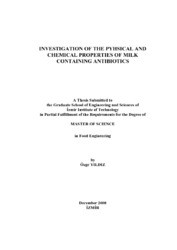Please use this identifier to cite or link to this item:
https://hdl.handle.net/11147/3888Full metadata record
| DC Field | Value | Language |
|---|---|---|
| dc.contributor.advisor | Ünlütürk, Sevcan | - |
| dc.contributor.author | Yıldız, Özge | - |
| dc.date.accessioned | 2014-07-22T13:52:35Z | - |
| dc.date.available | 2014-07-22T13:52:35Z | - |
| dc.date.issued | 2008 | - |
| dc.identifier.uri | http://hdl.handle.net/11147/3888 | - |
| dc.description | Thesis (Master)--Izmir Institute of Technology, Food Engineering, Izmir, 2008 | en_US |
| dc.description | Includes bibliographical references (leaves: 101-108) | en_US |
| dc.description | Text in English; Abstract: Turkish and English | en_US |
| dc.description | xiv, 122 leaves | en_US |
| dc.description.abstract | This work aimed to find a basic and rapid screening method for antibiotic residues in UHT whole cow.s milk. For this purpose an investigation was conducted to screen some physical (e.g. acidity, pH, density, freezing point and electrical conductivity), thermo-physical (e.g. melting temperature, heat of fusion, evaporation temperature and heat of evaporation) and chemical properties (e.g. fat%, protein%, lactose%, minerals%, SNF%) of antibiotic free milk and milk fortified by Penicillin G, Ampicillin, Tetracycline. We can able determine whether residue of antibiotics making any difference on these selected properties. Thermo-physical properties were measured by differential scanning calorimeter (DSC), (TA Instruments, USA) and chemical properties were determined by using Lactostar (Funke Gerber Inc., Berlin, Germany).Antibiotic residues were detected by Copan Milk Test, Penzyme Test and ROSA Test and by high performance liquid chromatography (HPLC) method for confirmation of screening tests. Due to some drawbacks of screening tests, liquid chromatography was required for confirmation of antibiotic residues in milk. HPLC method showed that average recoveries of spiked Penicillin G at 2, 4, 8 ppb, spiked Ampicillin at 2, 4, 8 ppb and spiked Tetracycline at 100, 250, 500 ppb were ranged from 44.67% to 66.00%, from 62.50% to 87.52% and from 92.86% to 94.35%, respectively.We found that the acidity, pH and density of milk were independent of Penicillin G, Ampicillin and Tetracycline concentrations. Electrical conductivity (EC) were evaluated by applying ANOVA with Fisher.s test and Probabilistic neural network (PNN) method. ANOVA was also performed for DSC and Lactostar measurement results. This evaluation suggested that EC measurement can be a great promising technique for detection of antibiotic residues in milk, DSC is a good characterization tool for understanding of thermal events and the presence of antibiotic residues in milk influencing freezing point and minerals (EMC)%. | en_US |
| dc.language.iso | en | en_US |
| dc.publisher | Izmir Institute of Technology | en_US |
| dc.rights | info:eu-repo/semantics/openAccess | en_US |
| dc.subject.lcc | SF253. Y52 2008 | en |
| dc.subject.lcsh | Milk--Analysis | en |
| dc.subject.lcsh | Antibiotic residues--Testing--Laboratory manuals | en |
| dc.title | Investigation of the Pyhsical and Chemical Properties of Milk Containing Antibiotics | en_US |
| dc.type | Master Thesis | en_US |
| dc.institutionauthor | Yıldız, Özge | - |
| dc.department | Thesis (Master)--İzmir Institute of Technology, Food Engineering | en_US |
| dc.relation.publicationcategory | Tez | en_US |
| dc.identifier.wosquality | N/A | - |
| dc.identifier.scopusquality | N/A | - |
| item.openairecristype | http://purl.org/coar/resource_type/c_18cf | - |
| item.languageiso639-1 | en | - |
| item.openairetype | Master Thesis | - |
| item.grantfulltext | open | - |
| item.fulltext | With Fulltext | - |
| item.cerifentitytype | Publications | - |
| Appears in Collections: | Master Degree / Yüksek Lisans Tezleri | |
Files in This Item:
| File | Description | Size | Format | |
|---|---|---|---|---|
| T000778.pdf | MasterThesis | 2.15 MB | Adobe PDF |  View/Open |
CORE Recommender
Page view(s)
242
checked on Mar 31, 2025
Download(s)
198
checked on Mar 31, 2025
Google ScholarTM
Check
Items in GCRIS Repository are protected by copyright, with all rights reserved, unless otherwise indicated.